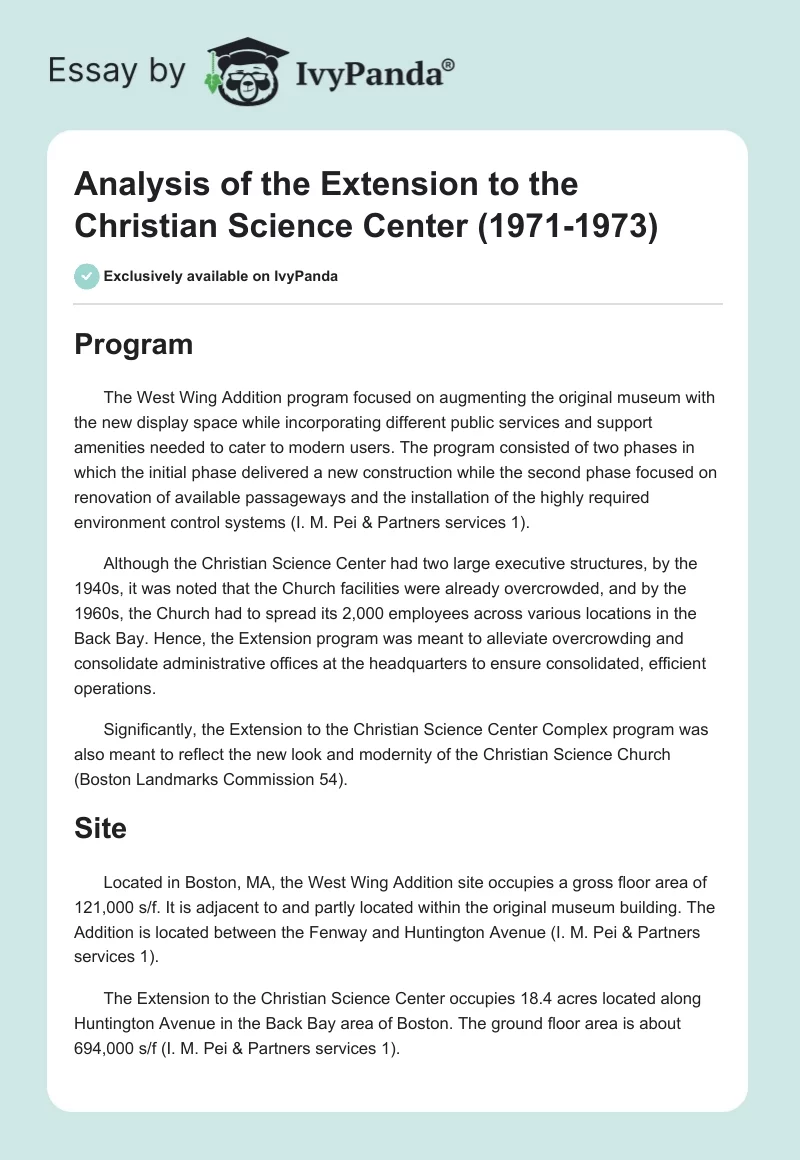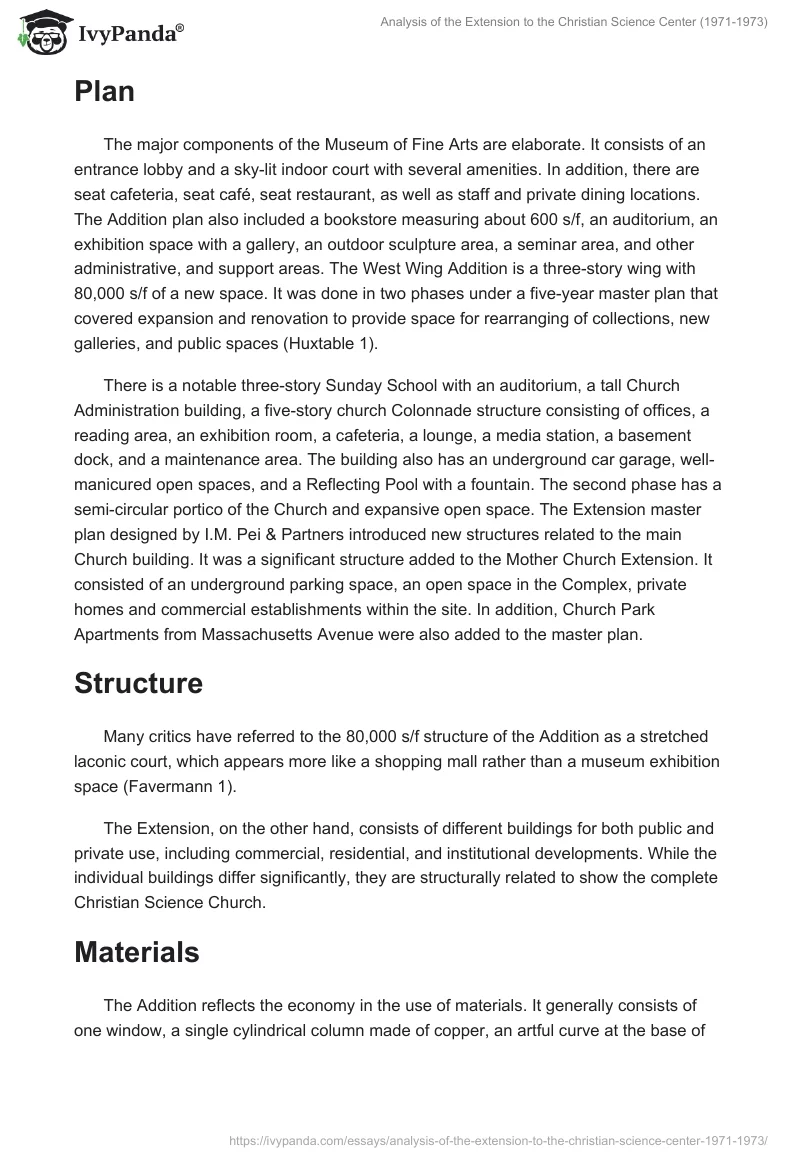Program
The West Wing Addition program focused on augmenting the original museum with the new display space while incorporating different public services and support amenities needed to cater to modern users. The program consisted of two phases in which the initial phase delivered a new construction while the second phase focused on renovation of available passageways and the installation of the highly required environment control systems (I. M. Pei & Partners services 1).
Although the Christian Science Center had two large executive structures, by the 1940s, it was noted that the Church facilities were already overcrowded, and by the 1960s, the Church had to spread its 2,000 employees across various locations in the Back Bay. Hence, the Extension program was meant to alleviate overcrowding and consolidate administrative offices at the headquarters to ensure consolidated, efficient operations.
Significantly, the Extension to the Christian Science Center Complex program was also meant to reflect the new look and modernity of the Christian Science Church (Boston Landmarks Commission 54).
Site
Located in Boston, MA, the West Wing Addition site occupies a gross floor area of 121,000 s/f. It is adjacent to and partly located within the original museum building. The Addition is located between the Fenway and Huntington Avenue (I. M. Pei & Partners services 1).

The Extension to the Christian Science Center occupies 18.4 acres located along Huntington Avenue in the Back Bay area of Boston. The ground floor area is about 694,000 s/f (I. M. Pei & Partners services 1).

Plan
The major components of the Museum of Fine Arts are elaborate. It consists of an entrance lobby and a sky-lit indoor court with several amenities. In addition, there are seat cafeterias, seat café, seat restaurants, as well as staff and private dining locations. The Addition plan also included a bookstore measuring about 600 s/f, an auditorium, an exhibition space with a gallery, an outdoor sculpture area, a seminar area, and other administrative, and support areas. The West Wing Addition is a three-story wing with 80,000 s/f of a new space. It was done in two phases under a five-year master plan that covered expansion and renovation to provide space for rearranging of collections, new galleries, and public spaces (Huxtable 1).
There is a notable three-story Sunday School with an auditorium, a tall Church Administration building, a five-story church Colonnade structure consisting of offices, a reading area, an exhibition room, a cafeteria, a lounge, a media station, a basement dock, and a maintenance area. The building also has an underground car garage, well-manicured open spaces, and a Reflecting Pool with a fountain. The second phase has a semi-circular portico of the Church and expansive open space. The Extension master plan designed by I.M. Pei & Partners introduced new structures related to the main Church building. It was a significant structure added to the Mother Church Extension. It consisted of an underground parking space, an open space in the Complex, private homes, and commercial establishments within the site. In addition, Church Park Apartments from Massachusetts Avenue were also added to the master plan.
Structure
Many critics have referred to the 80,000 s/f structure of the Addition as a stretched laconic court, which appears more like a shopping mall rather than a museum exhibition space (Favermann 1).
The Extension, on the other hand, consists of different buildings for both public and private use, including commercial, residential, and institutional developments. While the individual buildings differ significantly, they are structurally related to show the complete Christian Science Church.
Materials
The Addition reflects the economy in the use of materials. It generally consists of one window, a single cylindrical column made of copper, an artful curve at the base of the façade at the entrance, and one glass vault directly above the reduced atrium (Monchaux 1).
The Extension consists of various structures that are unified by materials, design, and color. It has piers just above the ground, textural façades, and window glazing without frames (Boston Landmarks Commission 57). Further, there are arched, rectangular windows with translucent glass panes decorated with textured, painted materials.
Concretes and metals are generally used in all structures while the Maine granite is prominent in the Addition. The Extension also features limestone, granite, and marble.
Enclosure
The enclosure of both the Addition and Extension are meant to enhance the efficiency and functionality of the buildings. The addition is large to improve circulation. Moreover, there is a large gallery for shops, restaurants, auditoriums, bookstores, and other different amenities.
Conversely, the Extension consists of different structures with varied purposes, including residential, commercial, and administrative. These structures are designed to improve efficiency and functionality for users.
Entrances
The Addition has a new entrance to enhance circulation through convenience in parking. In fact, the entrance has made the West Wing be an independent small museum within the main one. It can remain open and serve visitors without necessarily running the whole museum.
The Christian Science Center has multiple entrances with the main one at the one-story section of the Original Mother Church. Several asymmetrically located entrances can be found in the west, north, and south of the center.
Organization of Spaces and Functions
The chief reason for the Addition was to enhance circulation after some previous renovations had left confusing pathways with closed-end corridors. The West Wing Addition, with a long loop in the entire museum, is organized with the galleria consisting of a sky-lit-enclosed court. In fact, the galleria is now the focus of the museum because of both the visual and physical effects it adds to the public spaces, including dining, bookstores, auditorium, and exhibition rooms. Now visitors can socialize, eat, attend lectures, and watch exhibitions and other events at the West Wing.
The Extension was meant to introduce a more open and friendly place for the headquarters of the Church while regenerating the neighboring structures. In this case, the design functions as the unifying factor in the Extension. Overall, the Extension aimed for an open space, improved housing, traffic, parking lots, and convenient shopping for the neighborhood while improving the overall valuation of Boston and tax revenues for the government.
Circulation
The Addition, as previously noted, was designed to improve circulation by eliminating long, dead-end corridors and confusing rooms left after renovations. In fact, some critics noted that exhibition and viewing were now subordinate to circulation in the museum because of its ‘shopping mall’ appearance.
The Extension circulation was improved with the additional stone portico to halls. Besides, the new design was meant to improve convenience to residents and in the neighborhood by providing greater traffic flow.
Works Cited
Boston Landmarks Commission. Christian Science Center Complex: Study Report. Boston: Boston Landmarks Commission, 2011. Print.
Favermann, Mark. “Linde Family Wing for Contemporary Art.” Berkshire Fine Arts. 2011. Web.
Huxtable, Ada Louise. “Architecture View: Pei’s Elegant Addition to Boston’s Arts Museum.” The New York Times. 1981. Web.
I. M. Pei & Partners services. Projects: Boston, Massachusetts. n.d. Web.
Monchaux, Thomas De. “Museum of Fine Arts Boston.” The Architect’s Newspaper. 2011. Web.


